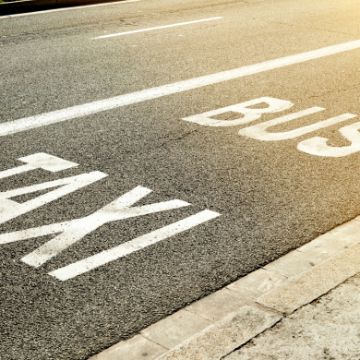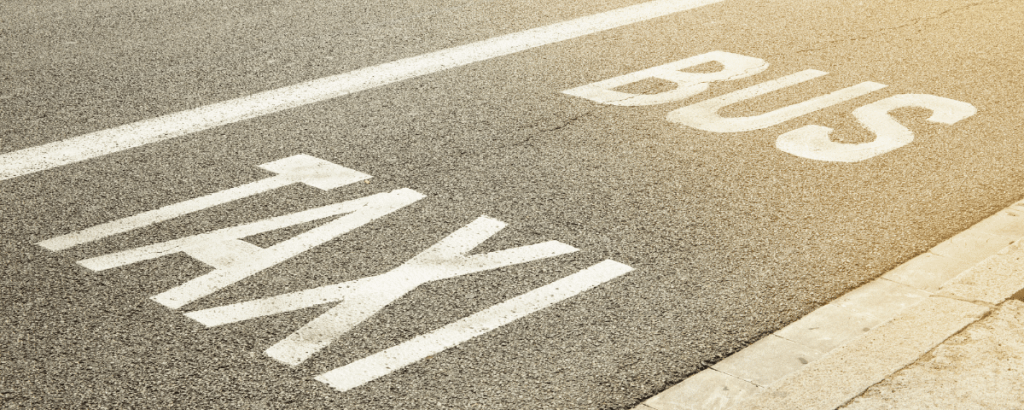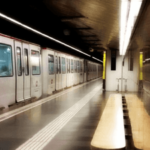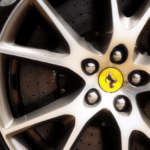Getting Around in Barcelona (public transportation and more)
BEST TIPS TO GET AROUND BARCELONA EFFICIENTLY

One issue difficult to figure out when planning your sightseeing is how to get around. Is it going to take long? How good and safe the public transit in Barcelona will be?
This week tips will help you deciding what’s the best way of getting around Barcelona in for you. It really depends a lot on your style and budget, but here are some ideas to take into account.
Is Barcelona walkeable?
1
Getting around Barcelona on foot
As long as you plan your sightseeing by zones, of course. On the same day you explore la Rambla you can also do the Gothic Quarter, the Raval and the Picasso Museum or the Palau de La Música Catalana. Or head to La Barceloneta afterwards.
It is also easy to do La Rambla or the Gothic Quarter together with Passeig de Gràcia, with Casa Batllo and Casa Mila.
You can walk from Passeig de Gracia to Sagrada Familia if you want, but it’s some 30 minutes with not much to do on the way. Subway is your best way to go here.
Walking to Park Guell is probably not an option: 1 hour walk uphill from most of the other sites. Although if you have the energy you might want to back to the city center through the squares of Gracia after visiting the park.
And while you’ll need transportation to get to Montjuic, exploring it is best done by foot unless you prefer just a quick ride through (we’ll discuss later how).
Check out my time-efficient recommendations for your stay:
How to get around Barcelona using public transportation
2
Bus
Bus lines starting with an H run mostly horizontally across Barcelona. Lines starting with a V go pretty much vertically. And there’s a just a few starting with a D that cross the city diagonally. This is specially helpful when you aren’t familiar with the city districts but know the rough direction in which you need to go.
There’s also a system of neighborhood buses designed mostly for locals. They are small minibuses and their frequency is very reduced.
- What tickets can I use? You can get a 10-trip T-Casual card from subway ticket machines as well as tobacco shops (called “Estanco”). Bus drivers don’t sell single tickets: instead there’s a machine where you approach a credit or debit card and it charges you for the ticket (no ticket is issued, but if you cross a controller they’ll be able to check you paid from the card you used. There’s also an 8-trip card called “Familiar” that can be shared (T-Casual is unipersonal), but it expires within 30 days).
- Are they included in any city pass? If you are planning to get around Barcelona using public transportation more than walking, then consider getting an Hola Barcelona day pass or the Barcelona Card, that besides access to the Barcelona public transport system also offers you interesting discounts on sites and restaurants.
- What’s the bus schedule? Bus schedule and frequency depends a lot on the line. You’ll find a notice in the bus stop, or you can check it online here. I personally use this app to check when the next bus is coming, but Google Maps is also pretty accurate. Plus once in the bus, it tells you when your stop is approaching!
- When are you likely to need a bus for sightseeing? Bus in one of the easiest ways to get to Park Guell. You might also want to check this other post about bus lines that you can use as an alternative to the Tourist Bus. It includes the best buses to move around Montjuic, as I promised before!
3
Metro
The Metro is a favorite way to get around the city, because it is fast, reliable and very frequent. It will often save you some walk when you are short of time.
- What tickets can you use? You can buy your tickets in the machines at all the metro stations. They take credit cards (with a PIN!) as well as cash. Just like for buses, your best choices depending on your travel frequency and budget are a one-way ticket, a 10-trip T-Casual, a day pass or a city pass. Take into account that the T-Casual is a personal card and you cannot share it. If you need to share, consider the T-Familiar instead.
- What are the metro operating hours? Consider roughly that you’ll be able to use it from 5AM to midnight. On Fridays and Saturdays it usually goes longer, but this has been fluctuating due to the pandemic and curfews… If you need to use it at night, check the most updated schedule here.
- When will you need to take the metro for getting around Barcelona?
- The L1 will take you from Plaça Catalunya to Plaça Espanya, so you can start exploring Montjuic from there.
- The L2 connects Passeig de Gracia with Sagrada Familia. It also takes you to Paral·lel, where you can switch to the Montjuic Funicular.
- The L3 goes along La Rambla and Passeig de Gracia, then it continues to Lesseps and Vallcarca – the closest stations to Park Guell… if you don’t mind the long walk there uphill!
- The L4 will take you from the city center to the beach.
- The L5 takes you to Sagrada Familia from Passeig de Gracia.
- The L9 takes you to the airport, although it’s not always the most convenient transportation means…
- Anything else you need to know about the Barcelona metro? In our blog we share our best Barcelona metro tips about how to use the metro like a local.
4
Taxis
- How much is the average ride? You should pay only what the meter says. A 10 minute ride shouldn’t be more than 5-12 euro, a longer ride across the city is around 15 euro, and a ride to the Prat airport is around 25-30 euro.
- Is there Uber instead? I’m afraid the taxi lobby has forcefully fought Uber, seeing it as unfair competition. So even if Uber finally got permission to operate legally, they have almost no drivers working for them, what makes the app useless. The alternative I use to call a taxi is Free Now. It also offers the option of paying a fixed price for the ride, and while in my experience it usually ends up being 1 or 2 euro more expensive, it can be worth it if you are scared your driver might try to cheat on you.
- Any other tips about Barcelona taxis? Our blog also covers the best tips to use taxis like a Barcelona local and avoid being cheated.
5
Hop-on Hop-off buses
you are right across the city and have to wait another hour or so before you approach the center again…. But they can be convenient for some travelers.
There are two hop-on hop-off bus companies operating in Barcelona. One is run by the City Council, and the other is run by a private bus company, Julià. They cover pretty much the same sites, though and the main difference is that one gives you discounts and the other doesn’t. Both include audio-guide services on board but no in-person tour guide explanations.
BARCELONA BUS TURÍSTIC (City Council)
- How many lines are there?
- Blue Route. It starts in Plaça Catalunya and goes up Passeig de Gracia with stops by Casa Batllo and Casa Mila (La Pedrera). Then it continues to Sagrada Familia and the modernist Hospital of Sant Pau. A fit further is the stop of Park Guell – but don’t be fooled: you don’t see even a glimpse of it from the bus. It’s a 5 minute walk uphill from there. Next follows a relatively long section with little interest (minor stops to connect with the bus to Tibidabo, explore the Sarria District, visit the Monastery of Pedralbes or some very minor Gaudi sites), until you reach the FC Barcelona Stadium. After that, it goes back to Plaça Catalunya through a bland route.
- Red Route. It also starts in Plaça Catalunya and goes up Passeig de Gracia, but then heads to Sants Station (unnecessary?) to then proceed to the Hill of Montjuic where there are several stops. But Montjuic being so walkeable, it’s unlikely that you’ll end up using it to move around the Hill. You’ll probably just hop off somewhere, walk around, and hop on again somewhere else. After Montjuic, the red route goes along the waterfront via Port Vell and Port Olimpic, and heads back to Plaça Catalunya passing by the Ciutadella Park and the Gothic Quarter. This route is quite scenic and convenient if you just want to seat on the bus and be shown around.
- Green Route. This line only operates in the Summer, making your access to the beaches beyond Port Olimpic easier.
- Other seasonal routes. During the Christmas season there’s a route to see the Christmas lights from the bus. In the Summer there’s also a special route at night to show you the sites lit up. They are not included in the regular price, and they have special fees.
- What is the cost of the tickets? The price depends on the number of days you purchase. You can check the price list here, but it’s around €30 for a one-day ticket. This is often the cost of a regular guided bus-tour, but the ticket includes discounts for sites and restaurants.
BARCELONA CITY TOUR HOP ON – HOP OFF (by Julià Tours)
- Orange Route. It covers the West of the city, including Passeig de Gracia, Montjuic Hill and Camp Nou.
- Green Route. It covers the East of the city, overlapping with the Orange Route in Passeig de Gràcia, but then taking you also to the Gothic Quarter, the Beach area, Sagrada Familia, Sant Pau Hospital, Park Guell (again, an uphill walk from the stop) and the connection with the bus to Tibidabo.
- What is the price of the tickets? Again, it depends on how many days you wish to book, but it’s wroughly half the price of the other company, but it does not include any discounts.
Which company is better?
I suggest you study the discounts offered by the City Council Tourist Bus and decide if you’ll be saving more than the price difference between both companies using the discounts.
6
FGC Trains
Did you notice I mentioned there’s 8 metro lines, but there are two lines called L9 and L10? That’s because L6 and L7 are not run by TMB (transportation authority of the City Council). They belong to the Generalitat de Catalunya government.
In 1863 was inaugurated the first transit railway in Barcelona, connecting the (then still independent) village of Sarria with Barcelona Plaça Catalunya. This line is now the L6 of the FGC or Ferrocarrils de la Generalitat de Catalunya. Locals also call them “ferrocarrils catalans” or for short and informally, “ferrocates”.
You are not likely to use this line unless you are heading to Sarria to eat some patatas bravas at Tomas or are staying somewhere along this line. Because even if it stops close to La Pedrera and the Gracia District, the metro L3 line will be more convenient for you.
The L7 takes you from Plaça Catalunya to Avinguda Tibidabo, and that can come handy if you want to go to the Amusement Park or to the CosmoCaixa science museum, because it connects with the buses heading there.
- What tickets can you use? You can use for L6 and L7 the same tickets you’ll use for bus and metro. There’s ticket machines at all the stations.
- What’s the operating hours of the FGC? They work from early in the morning until late at night, but the first and last departures depend a lot on the line. You can check them out here.
The FGC also run suburban trains. The S1 takes you to Terrassa (industrial heritage museum, some modernist buildings, church ruins), the S2 goes to Sabadell (opera and classic music theaters). The S6 overlaps with the S2 but ends in the Autonomous University of Barcelona, and the S7 overlaps with the S1 ending in the working class suburb of Rubí. All these lines top in stations that allow you to explore the Collserola Natural Park as well as in Sant Cugat (medieval monastery).
The FGC also have another network departing from Plaça Espanya and heading to the suburbs. They are convenient to reach the Fira II (convention centers and trade shows). And here are some other stations that are worth taking into account:
- Colònia Guell. S3, S4 S8 and S9. Visit Gaudi’s Cripta Güell.
- Aeri de Montserrat. R5 only. Connects with the Montserrat cable car to get to the Monastery.
- Monistrol de Montserrat. R5 and R50. Connects with the cremallera rack train to get to the Montserrat Monastery.
- Manresa Baixador. R5 and R50. Medieval town with impressive cathedral on top of a hill, and route of Saint Ignatius of Loyola. However, this station is relatively far from the old part of the city – you’ll be better off taking the Rodalies R4 train.
A NOTE ON TRAVEL ZONES. The tickets you use to get around Barcelona apply to Zone 1 of network of public transportation in Barcelona. When you hop on a suburban train, you are likely to enter Zones 2, 3 or further and therefore you’ll need a specific ticket to reach your destination. You can check the Zone you’ll be traveling to here.
7
Rodalies trains
So now you’ll mostly see it called “Rodalies”, in Catalan. There’s 8 Rodalies lines, all of them stopping in Sants Estació, There’s a few more train stations in Barcelona, Plaça Catalunya, Arc de Triomf and Passeig de Gracia being the most central. But locals don’t usually use them to move around the city because the metro often overlaps and has more frequency.
- What tickets can you use? If you are just using it as an alternative to metro for getting around in Barcelona, any ticket that you can use in bus or metro works. But as soon as you exit Zone 1, you’ll need a specific ticket.
- When are you likely to use the Rodalies trains? Mainly for the R2N that takes you to the airport. The R2 South takes you to the beaches of Sitges and Garraf, and the R11 to the beaches of the Maresme County. The R4 could be an option to reach the Penedes wine country, too.
- Are there regional and long distance trains, too? There are regional trains taking you to Tarragona, Lleida, Girona and the French border. There’s long distance trains connecting with Madrid and the Basque Country, and a high speed train going to from Madrid to Paris with stops in Barcelona, Girona and Figueres (Salvador Dali museum).
8
Tram lines
But are you likely to need to use it for your sightseeing? Not much really. Sure, T1-T2-T3 take you as close as it gets to the Camp Nou Stadium (10 minutes walk from it). But since it does not connect with the city center, you’ll probably prefer to use the L3 all the way there rather than switching over to the tram just for a few stops.
You might want to use T4 to go from the Olympic Village to the Encants flea market in Glories, and then continue through the Poblenou 22@ district and Diagonal Mar. But… that’s only if you a planning a route of the newest contemporary buildings in town.
Wasn’t there a Blue Tram?
Yes, there used to be a vintage Blue Tram connecting Plaça Kennedy with the Tibidabo Funicular (now called Cuca de Llum, see below). Unfortunately, it’s currently out of service due to renovation works and there’s not a date to have it back yet.
9
Night buses - Nitbus
If you’ll be out partying late at night and won’t pay for a taxi to get back to your hotel, you’ll want to know that after the subway closes down, there’s a network of night buses departing from Plaça Catalunya and heading towards different areas of the city.
There’s 20 lines, and they can be used with your regular subway/bus tickets and passes. More information here.
10
How to get around barcelona from airport
Unique Public Transport in Barcelona
11
Cable Cars
There are two cable cars in Barcelona, that are more a tourist attraction than a transportation means locals use on their daily lives.
The Aeri del Port goes across the Port Vell marina connecting the end of the Barceloneta district with the Hill of Montjuic. It comprises 2 vintage red cabins with room for 20 passengers. Since the entire ride takes almost 10 minutes, the lines move slowly and you can be waiting more than half an hour in peak hours.
The Teleferic de Montjuic is located 10 minutes walk from the Montjuic station of the Aeri del Port, what makes it easy to do both on the same day. It is a more modern cablecar, similar to the ones in ski resorts. It takes you all the way up to Montjuic Castle, with the option of stoping over at the Mirador de l’Alcalde viewpoint on the way down.
12
Funiculars
There’s 3 funiculars in Barcelona! And the best part is that 2 of them are included in the public transportation system, what means you don’t have to pay extra to use them if you already have a transportation card.
The Funicular de Montjuic goes from Parallel metro station (L2 & L3) halfway to the top of the Hill of Montjuic. The station is underneath the Teleferic de Montjuic cable car station, what makes an easy connection (except that you have to pay for the cable car). You’ll also be walking distance from the Miro Foundation and the Olympic Ring, so it makes a great starting point to explore the area. This funicular runs completely underground, with no views.
The Funicular de Vallvidrera can be reached by FGC (S1 & S2, but still within Zone 1), spotting at Peu del Funicular. It stops in Carretera de les Aigües (if you press the button to request it), a popular road for jogging, biking, walking the dog or watching the city views. Then it continues to Vallvidrera, a quaint neighborhood from where you can hike the Collserola mountains or take the 111 bus to the Tibidabo Amusement Park and the Basilica. It’s an outdoors funicular offering some city views.
The 3rd funicular in Barcelona also takes you to the Tibidabo, and it’s the only one that is no included in the Barcelona transportation cards because it is considered kind of like a preliminary ride of the amusement park. Locals call it “Cuca de llum” (firefly) because it is illuminated at night.
To take it you need to get the 196 bus from Plaça Kennedy (reachable by Hop-On Hop-Off buses or L7 of the FGC). If you have tickets for the Tibidabo Amusement park, the Cuca de Llum is free. Otherwise you can purchase tickets at the station. This is also an outdoor funicular and the city view are quite impressive.
13
Escalators and Elevators
Barcelona started installing outdoor escalators in hilly neighborhoods back in the 1980’s and they make part of the locals’ everyday life. They are not a novelty anymore. You’ll see some along Baixada de la Gloria if you decide to take the metro to Vallcarca to get to Park Guell. They are often broken, though. There’s also escalators connecting the Magic Fountain with the MNAC museum, and the rear of the MNAC museum with the Olympic Ring.
More recent is the addition of elevators, also as an alternative to stairs or to connect two areas that couldn’t be connected otherwise. In some cases they are regular outdoors elevators: In other cases, like the ones in Telegraf street, they are like mini-funiculars on rails. The one in Ciutat Meridiana is even more unique because it runs over a bridge rather than on land.
Getting around Barcelona on your own (or rental) vehicle
14
Bicycles
Locals living in Barcelona and having a local bank account can register for the Bicing service and pay a yearly fee to use the red and white bikes distributed all around the city. Motorized bikes come at an extra cost.
Unfortunately, if you are just here visiting you won’t be able to use them. Your only other chance is to rent a bike. There’s many rental bike companies in town, and many organize tours as well. We have compiled our favorite bike tours here.
15
Scooters
Barcelona is the second city in Europe in scooters and motorbikes, just under Rome. If you can ride a bike and want to feel like a local, it could be a fun idea to rent a scooter to move around. After all, you can park pretty much anywhere and it’s even faster than the metro most of the time.
However, if you aren’t an experience bike rider and aren’t familiar with the city layout, first consider if you’ll feel safe driving around surrounded by cars that trust you know what you are doing, while following the GPS directions to get to your destination. If it sounds scary… maybe stick to a bicycle instead.
15
Getting around in Barcelona by car
Getting around Barcelona by car is not the best idea. First of all, cars not meeting some non-polluting standards and older than a certain age are banned from entering the city or to drive around it Mon-Fri from 8AM to 8PM. Plus the traffic makes it a slow means of transportation.
And you’ll end up having to pay everywhere to park. Either a public parking lot, or the Blue Area (Mon-Fri 9AM to 8PM unless otherwise stated in the street signs) or the Green Area that is extra expensive for non-residents. But if you must, you’ll thank me for recommending you this app.
If you came to Barcelona by car, leave it parked in your hotel. You’ll only really need a car if you are planning to do day trips around Barcelona .
How are you planning getting around in Barcelona?
Marta
MORE BARCELONA TIPS FOR YOU:
SHARE WITH YOUR TRAVEL MATES
RESEARCHING FOR A TRIP IS TIME-CONSUMING…
Need more inspiration?
Our 100% FREE Barcelona Collection will give you everything you need to organize the trip of your lifetime to Barcelona.
BEST INSIDER TIPS FROM THE PROS!











